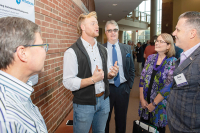A renewed appreciation for ‘The Great Gatsby’
 In 1977 I fell in love with F. Scott Fitzgerald’s The Great Gatsby.
In 1977 I fell in love with F. Scott Fitzgerald’s The Great Gatsby.
That was a year of deep reading for me — Tolstoy, Dostoyevsky, Faulkner, Flaubert, and so many others — but it was Gatsby I loved. The novel obsessed me, not so much for its characters or its plot or its literary symbols as for the rhythms of its sentences and the juxtaposition of unlikely adjectives and nouns.
I wanted to write, and every day I would open Gatsby at random and read sentences like this one — “If personality is an unbroken series of successful gestures, then there was something gorgeous about him, some heightened sensitivity to the promises of life, as if he were related to one of those intricate machines that register earthquakes ten thousand miles away.” Here was a music I wanted to make my own.
This love for The Great Gatsby has ridden in the nighttime skies of my heart like phases of the moon, waxing and waning, sometimes shining bright, sometimes thinning to just a sliver of light. But it was always there, a constant in my own inconstancy, always waiting for me when I returned, always giving me on each of those returns new gifts. This was a love that never let me down, that always rewarded me for my attention, which offered new insights of heart and mind with each visit.
Over the years, Gatsby led me deeper and deeper into Fitzgerald himself. I read his other novels and many of his stories, his letters, and the biographies of him and Zelda. I explored the places where he had lived in Asheville when Zelda was here being treated for her madness; I visited their grave in Old Saint Mary’s cemetery in Maryland. I have debated doubters on the greatness of Gatsby and have annually taught Fitzgerald’s book in the Advanced Placement English seminars I offer to homeschool students in the Asheville area.
My admiration for the book eventually became comfortable as the proverbial old shoes. I never became jaded or blasé about its importance, and maintained my high regard for its many wonders, but time and familiarity had left a patina of dust on my ardor. Like the shoes, the book fit me well, and I thought less and less about its place in literature and in my life.
Related Items
Well, that sense of comfortable familiarity has been blasted away, and the luster of Gatsby is restored. In the last two weeks, I have read and reread Maureen Corrigan’s So We Read On: How The Great Gatsby Came to Be and Why It Endures (Little, Brown and Company, 2014, $25). Corrigan, the book critic for NRP’s Fresh Air, has polished up my spectacles and made me look at Gatsby with a new pair of eyes.
Corrigan is as deeply enamored of Gatsby as the rest of us who love this book, but unlike the rest of us, she conveys her passion in a splendid mix of biography, anecdote, and personal musings. She examines the origins of the book, its initial failure to sell well — Fitzgerald died believing himself a complete failure — its impact in classrooms and reading groups, its place in film and theater.
Even better, So We Read On illuminates again and again points from The Great Gatsby that others of us, including at times Corrigan herself, have missed in our many readings. At the end of Gatsby, for example, Nick visits Gatsby’s darkened mansion one last time. Standing outside, he sees “on the white steps an obscene word, scrawled by some boy with a piece of brick,” and he erases the word, “drawing my shoe raspingly along the stone.” A reader whom Corrigan meets in her travels points out that this erasure is Nick’s final act of cleaning up the mess caused by Gatsby’s murder, thus bringing closure to the novel. Neither Corrigan nor I had ever made this connection.
Finally, in a chapter titled “A Second-Rate, Midwest Hack and the Masterpiece He Wrote,” Corrigan points out that “the more you read Gatsby, the curiouser and curiouser it gets.” She then lists these peculiarities: that Gatsby contains a great deal of humor; that in spite of its brevity — Fitzgerald told his story in less than 50,000 words — it is as an elaborate tapestry as any modernist novel; that it is the only great novel that Fitzgerald ever wrote. (Some readers may challenge that statement with Tender Is The Night, but I side with Corrigan).
But it is Corrigan’s first point in her list of peculiarities that made me understand why I had fallen in love with The Great Gatsby so many years ago. Corrigan writes that “Gatsby is neither a character-driven nor a plot-driven novel; instead, it’s that rarest of literary animals: a voice-driven novel.”
As I say, when I read those words, I understood at last why my younger self had fallen in love with a book. At the time I thought that I wanted those singing words and beautifully crafted sentences, but what had really captivated me, I see now, was Nick’s voice. As Corrigan tells us, “Fitzgerald summons up a voice — call it the omniscient American voice — that renders the American dream irresistible and heartbreaking and buoyant, all at once.”
At the end of the novel, Fitzgerald wrote of “Gatsby’s wonder when he first picked out the green light at the end of Daisy’s dock.” Reading Maureen Corrigan has restored my own sense of wonder regarding The Great Gatsby.
Highly recommended.
So We Read On: How The Great Gatsby Came to Be and Why It Endures by Maureen Corrigan. Little, Brown and Company, 2014. 352 pages.









